100 Alexander College Exam Rules
VerifiedAdded on 2022/07/28
|9
|3714
|42
AI Summary
%00 Words assignment required by 12 :00 Noon 16th April 2020 Vancouver, Canada Time.
Contribute Materials
Your contribution can guide someone’s learning journey. Share your
documents today.
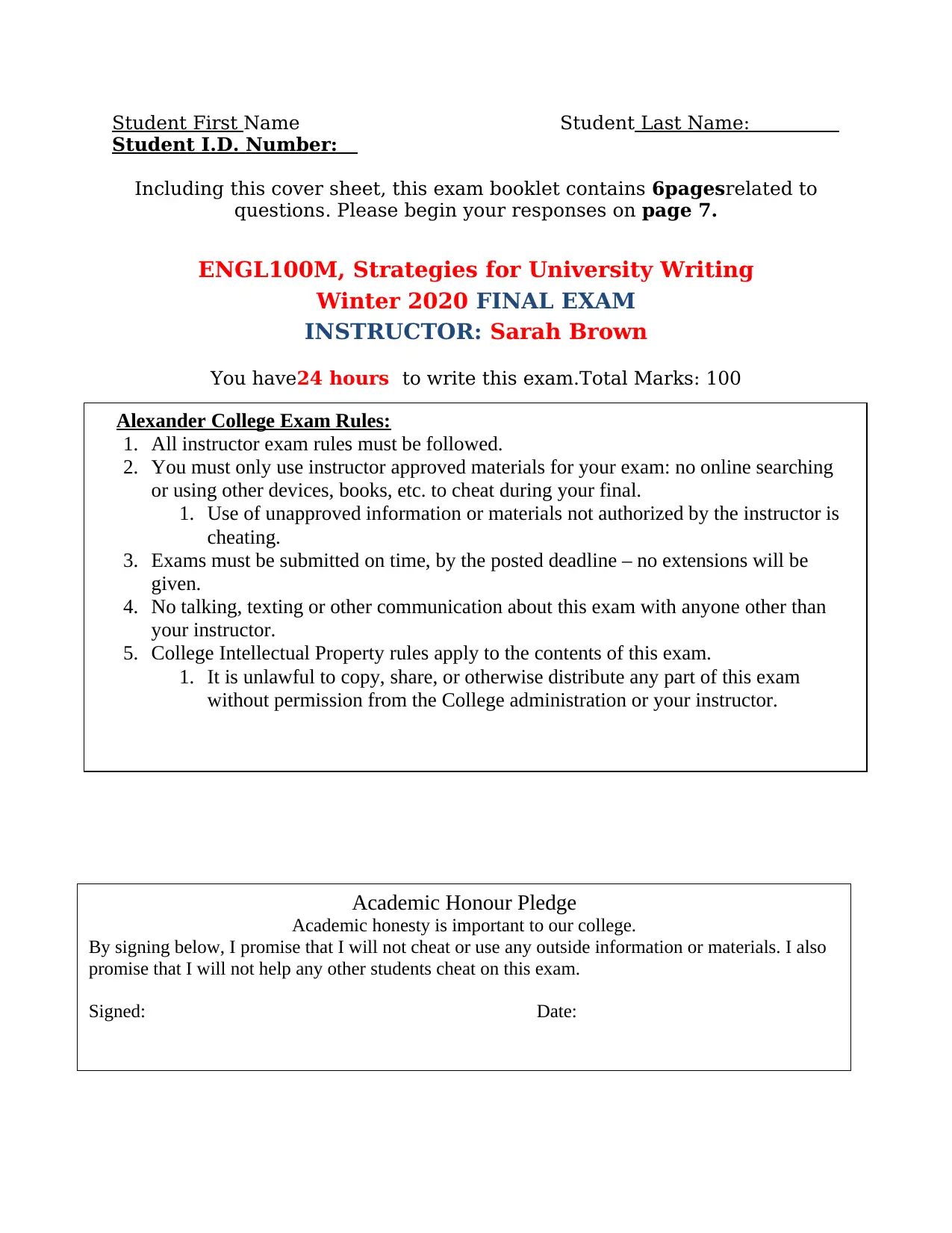
Student First Name Student Last Name:
Student I.D. Number:
Including this cover sheet, this exam booklet contains 6pagesrelated to
questions. Please begin your responses on page 7.
ENGL100M, Strategies for University Writing
Winter 2020 FINAL EXAM
INSTRUCTOR: Sarah Brown
You have24 hours to write this exam.Total Marks: 100
Academic Honour Pledge
Academic honesty is important to our college.
By signing below, I promise that I will not cheat or use any outside information or materials. I also
promise that I will not help any other students cheat on this exam.
Signed: Date:
Alexander College Exam Rules:
1. All instructor exam rules must be followed.
2. You must only use instructor approved materials for your exam: no online searching
or using other devices, books, etc. to cheat during your final.
1. Use of unapproved information or materials not authorized by the instructor is
cheating.
3. Exams must be submitted on time, by the posted deadline – no extensions will be
given.
4. No talking, texting or other communication about this exam with anyone other than
your instructor.
5. College Intellectual Property rules apply to the contents of this exam.
1. It is unlawful to copy, share, or otherwise distribute any part of this exam
without permission from the College administration or your instructor.
Student I.D. Number:
Including this cover sheet, this exam booklet contains 6pagesrelated to
questions. Please begin your responses on page 7.
ENGL100M, Strategies for University Writing
Winter 2020 FINAL EXAM
INSTRUCTOR: Sarah Brown
You have24 hours to write this exam.Total Marks: 100
Academic Honour Pledge
Academic honesty is important to our college.
By signing below, I promise that I will not cheat or use any outside information or materials. I also
promise that I will not help any other students cheat on this exam.
Signed: Date:
Alexander College Exam Rules:
1. All instructor exam rules must be followed.
2. You must only use instructor approved materials for your exam: no online searching
or using other devices, books, etc. to cheat during your final.
1. Use of unapproved information or materials not authorized by the instructor is
cheating.
3. Exams must be submitted on time, by the posted deadline – no extensions will be
given.
4. No talking, texting or other communication about this exam with anyone other than
your instructor.
5. College Intellectual Property rules apply to the contents of this exam.
1. It is unlawful to copy, share, or otherwise distribute any part of this exam
without permission from the College administration or your instructor.
Secure Best Marks with AI Grader
Need help grading? Try our AI Grader for instant feedback on your assignments.
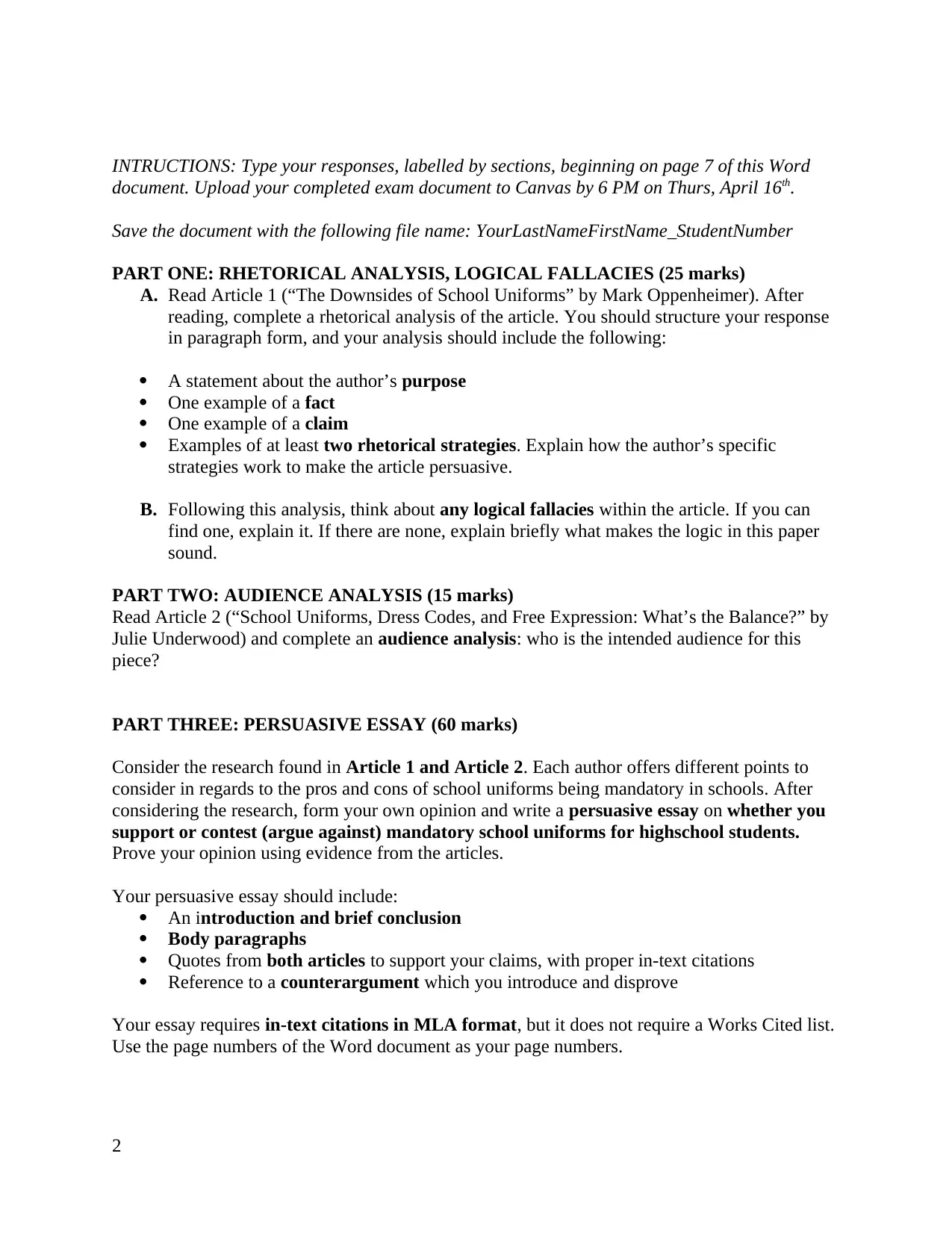
INTRUCTIONS: Type your responses, labelled by sections, beginning on page 7 of this Word
document. Upload your completed exam document to Canvas by 6 PM on Thurs, April 16th.
Save the document with the following file name: YourLastNameFirstName_StudentNumber
PART ONE: RHETORICAL ANALYSIS, LOGICAL FALLACIES (25 marks)
A. Read Article 1 (“The Downsides of School Uniforms” by Mark Oppenheimer). After
reading, complete a rhetorical analysis of the article. You should structure your response
in paragraph form, and your analysis should include the following:
A statement about the author’s purpose
One example of a fact
One example of a claim
Examples of at least two rhetorical strategies. Explain how the author’s specific
strategies work to make the article persuasive.
B. Following this analysis, think about any logical fallacies within the article. If you can
find one, explain it. If there are none, explain briefly what makes the logic in this paper
sound.
PART TWO: AUDIENCE ANALYSIS (15 marks)
Read Article 2 (“School Uniforms, Dress Codes, and Free Expression: What’s the Balance?” by
Julie Underwood) and complete an audience analysis: who is the intended audience for this
piece?
PART THREE: PERSUASIVE ESSAY (60 marks)
Consider the research found in Article 1 and Article 2. Each author offers different points to
consider in regards to the pros and cons of school uniforms being mandatory in schools. After
considering the research, form your own opinion and write a persuasive essay on whether you
support or contest (argue against) mandatory school uniforms for highschool students.
Prove your opinion using evidence from the articles.
Your persuasive essay should include:
An introduction and brief conclusion
Body paragraphs
Quotes from both articles to support your claims, with proper in-text citations
Reference to a counterargument which you introduce and disprove
Your essay requires in-text citations in MLA format, but it does not require a Works Cited list.
Use the page numbers of the Word document as your page numbers.
2
document. Upload your completed exam document to Canvas by 6 PM on Thurs, April 16th.
Save the document with the following file name: YourLastNameFirstName_StudentNumber
PART ONE: RHETORICAL ANALYSIS, LOGICAL FALLACIES (25 marks)
A. Read Article 1 (“The Downsides of School Uniforms” by Mark Oppenheimer). After
reading, complete a rhetorical analysis of the article. You should structure your response
in paragraph form, and your analysis should include the following:
A statement about the author’s purpose
One example of a fact
One example of a claim
Examples of at least two rhetorical strategies. Explain how the author’s specific
strategies work to make the article persuasive.
B. Following this analysis, think about any logical fallacies within the article. If you can
find one, explain it. If there are none, explain briefly what makes the logic in this paper
sound.
PART TWO: AUDIENCE ANALYSIS (15 marks)
Read Article 2 (“School Uniforms, Dress Codes, and Free Expression: What’s the Balance?” by
Julie Underwood) and complete an audience analysis: who is the intended audience for this
piece?
PART THREE: PERSUASIVE ESSAY (60 marks)
Consider the research found in Article 1 and Article 2. Each author offers different points to
consider in regards to the pros and cons of school uniforms being mandatory in schools. After
considering the research, form your own opinion and write a persuasive essay on whether you
support or contest (argue against) mandatory school uniforms for highschool students.
Prove your opinion using evidence from the articles.
Your persuasive essay should include:
An introduction and brief conclusion
Body paragraphs
Quotes from both articles to support your claims, with proper in-text citations
Reference to a counterargument which you introduce and disprove
Your essay requires in-text citations in MLA format, but it does not require a Works Cited list.
Use the page numbers of the Word document as your page numbers.
2
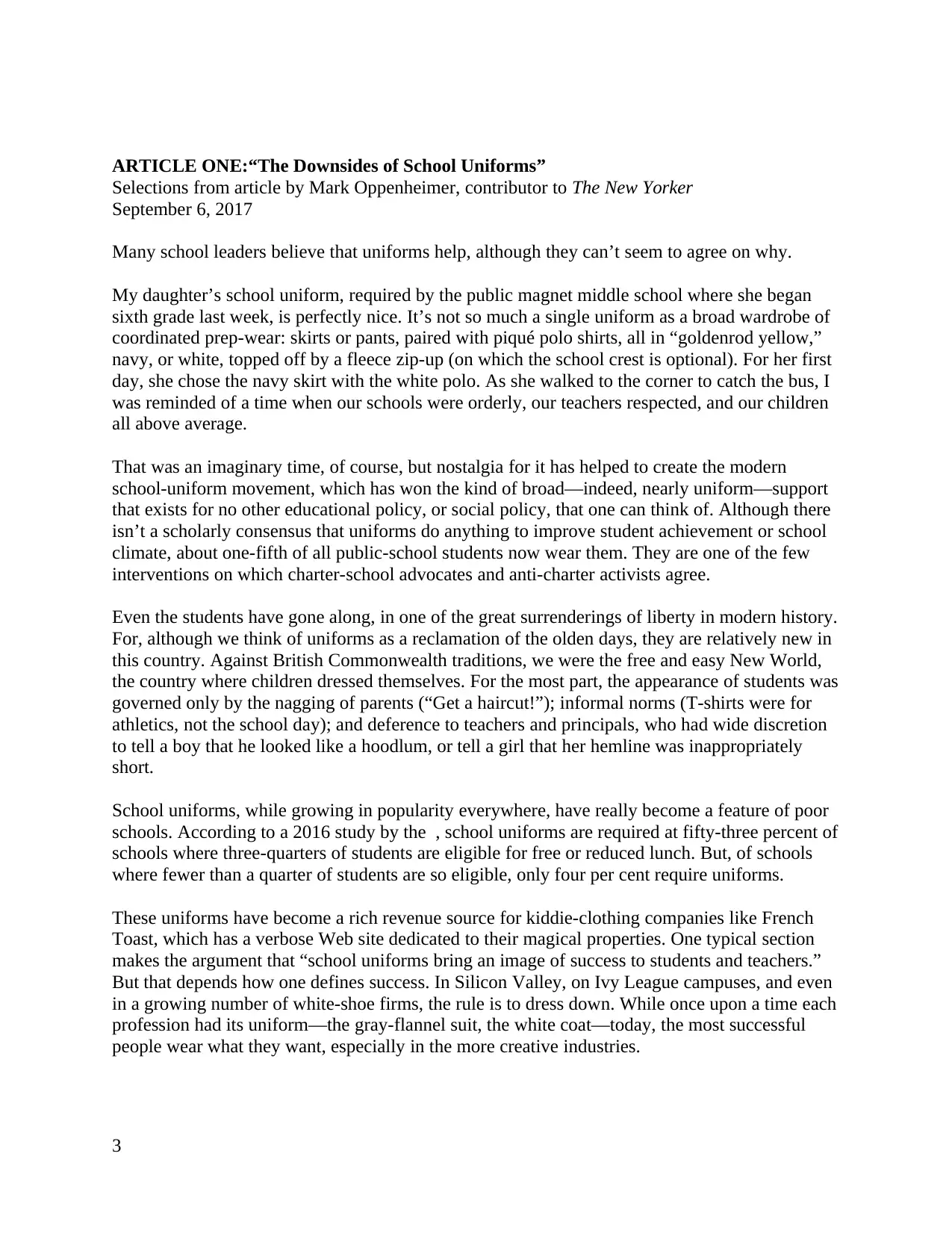
ARTICLE ONE:“The Downsides of School Uniforms”
Selections from article by Mark Oppenheimer, contributor to The New Yorker
September 6, 2017
Many school leaders believe that uniforms help, although they can’t seem to agree on why.
My daughter’s school uniform, required by the public magnet middle school where she began
sixth grade last week, is perfectly nice. It’s not so much a single uniform as a broad wardrobe of
coordinated prep-wear: skirts or pants, paired with piqué polo shirts, all in “goldenrod yellow,”
navy, or white, topped off by a fleece zip-up (on which the school crest is optional). For her first
day, she chose the navy skirt with the white polo. As she walked to the corner to catch the bus, I
was reminded of a time when our schools were orderly, our teachers respected, and our children
all above average.
That was an imaginary time, of course, but nostalgia for it has helped to create the modern
school-uniform movement, which has won the kind of broad—indeed, nearly uniform—support
that exists for no other educational policy, or social policy, that one can think of. Although there
isn’t a scholarly consensus that uniforms do anything to improve student achievement or school
climate, about one-fifth of all public-school students now wear them. They are one of the few
interventions on which charter-school advocates and anti-charter activists agree.
Even the students have gone along, in one of the great surrenderings of liberty in modern history.
For, although we think of uniforms as a reclamation of the olden days, they are relatively new in
this country. Against British Commonwealth traditions, we were the free and easy New World,
the country where children dressed themselves. For the most part, the appearance of students was
governed only by the nagging of parents (“Get a haircut!”); informal norms (T-shirts were for
athletics, not the school day); and deference to teachers and principals, who had wide discretion
to tell a boy that he looked like a hoodlum, or tell a girl that her hemline was inappropriately
short.
School uniforms, while growing in popularity everywhere, have really become a feature of poor
schools. According to a 2016 study by the , school uniforms are required at fifty-three percent of
schools where three-quarters of students are eligible for free or reduced lunch. But, of schools
where fewer than a quarter of students are so eligible, only four per cent require uniforms.
These uniforms have become a rich revenue source for kiddie-clothing companies like French
Toast, which has a verbose Web site dedicated to their magical properties. One typical section
makes the argument that “school uniforms bring an image of success to students and teachers.”
But that depends how one defines success. In Silicon Valley, on Ivy League campuses, and even
in a growing number of white-shoe firms, the rule is to dress down. While once upon a time each
profession had its uniform—the gray-flannel suit, the white coat—today, the most successful
people wear what they want, especially in the more creative industries.
3
Selections from article by Mark Oppenheimer, contributor to The New Yorker
September 6, 2017
Many school leaders believe that uniforms help, although they can’t seem to agree on why.
My daughter’s school uniform, required by the public magnet middle school where she began
sixth grade last week, is perfectly nice. It’s not so much a single uniform as a broad wardrobe of
coordinated prep-wear: skirts or pants, paired with piqué polo shirts, all in “goldenrod yellow,”
navy, or white, topped off by a fleece zip-up (on which the school crest is optional). For her first
day, she chose the navy skirt with the white polo. As she walked to the corner to catch the bus, I
was reminded of a time when our schools were orderly, our teachers respected, and our children
all above average.
That was an imaginary time, of course, but nostalgia for it has helped to create the modern
school-uniform movement, which has won the kind of broad—indeed, nearly uniform—support
that exists for no other educational policy, or social policy, that one can think of. Although there
isn’t a scholarly consensus that uniforms do anything to improve student achievement or school
climate, about one-fifth of all public-school students now wear them. They are one of the few
interventions on which charter-school advocates and anti-charter activists agree.
Even the students have gone along, in one of the great surrenderings of liberty in modern history.
For, although we think of uniforms as a reclamation of the olden days, they are relatively new in
this country. Against British Commonwealth traditions, we were the free and easy New World,
the country where children dressed themselves. For the most part, the appearance of students was
governed only by the nagging of parents (“Get a haircut!”); informal norms (T-shirts were for
athletics, not the school day); and deference to teachers and principals, who had wide discretion
to tell a boy that he looked like a hoodlum, or tell a girl that her hemline was inappropriately
short.
School uniforms, while growing in popularity everywhere, have really become a feature of poor
schools. According to a 2016 study by the , school uniforms are required at fifty-three percent of
schools where three-quarters of students are eligible for free or reduced lunch. But, of schools
where fewer than a quarter of students are so eligible, only four per cent require uniforms.
These uniforms have become a rich revenue source for kiddie-clothing companies like French
Toast, which has a verbose Web site dedicated to their magical properties. One typical section
makes the argument that “school uniforms bring an image of success to students and teachers.”
But that depends how one defines success. In Silicon Valley, on Ivy League campuses, and even
in a growing number of white-shoe firms, the rule is to dress down. While once upon a time each
profession had its uniform—the gray-flannel suit, the white coat—today, the most successful
people wear what they want, especially in the more creative industries.
3
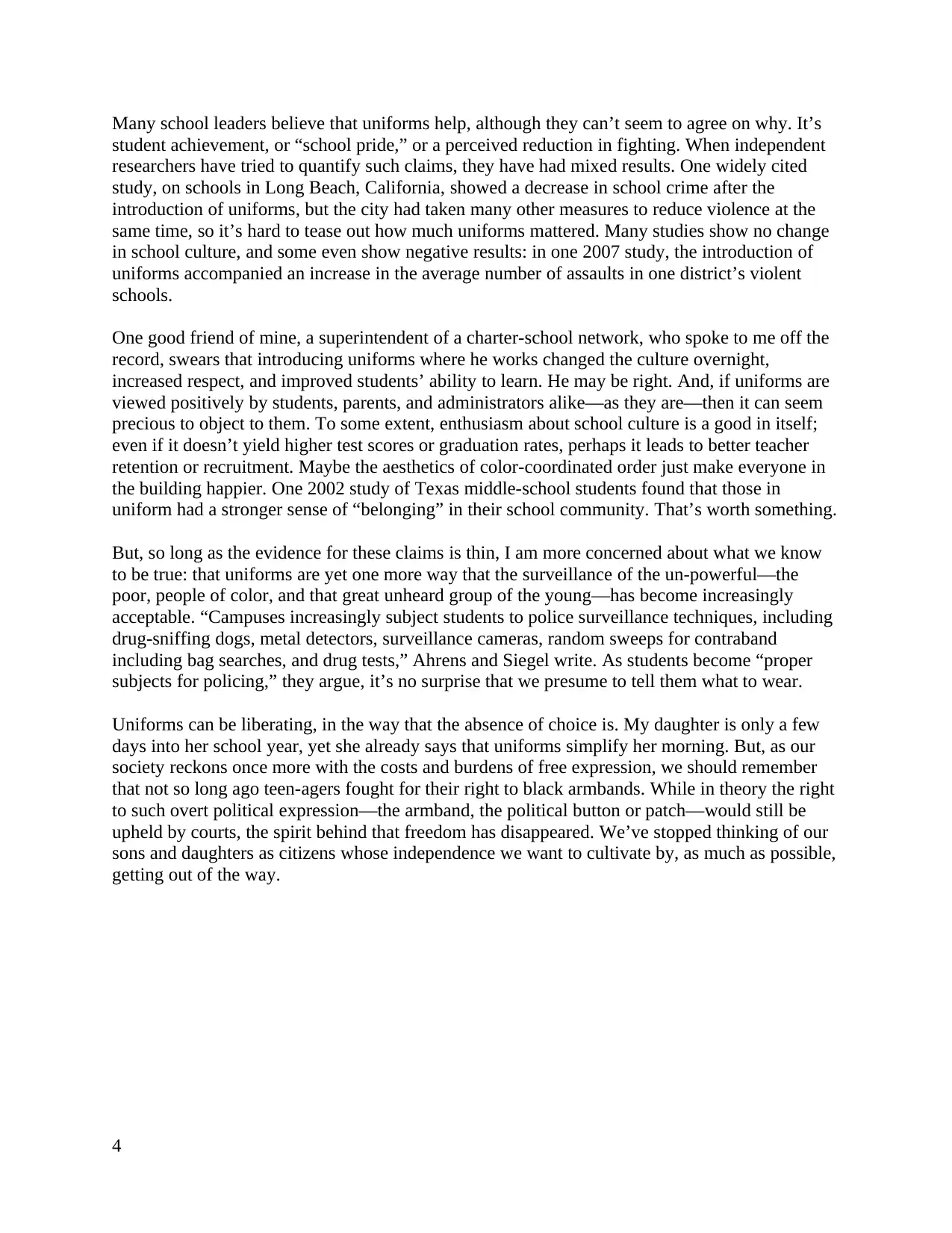
Many school leaders believe that uniforms help, although they can’t seem to agree on why. It’s
student achievement, or “school pride,” or a perceived reduction in fighting. When independent
researchers have tried to quantify such claims, they have had mixed results. One widely cited
study, on schools in Long Beach, California, showed a decrease in school crime after the
introduction of uniforms, but the city had taken many other measures to reduce violence at the
same time, so it’s hard to tease out how much uniforms mattered. Many studies show no change
in school culture, and some even show negative results: in one 2007 study, the introduction of
uniforms accompanied an increase in the average number of assaults in one district’s violent
schools.
One good friend of mine, a superintendent of a charter-school network, who spoke to me off the
record, swears that introducing uniforms where he works changed the culture overnight,
increased respect, and improved students’ ability to learn. He may be right. And, if uniforms are
viewed positively by students, parents, and administrators alike—as they are—then it can seem
precious to object to them. To some extent, enthusiasm about school culture is a good in itself;
even if it doesn’t yield higher test scores or graduation rates, perhaps it leads to better teacher
retention or recruitment. Maybe the aesthetics of color-coordinated order just make everyone in
the building happier. One 2002 study of Texas middle-school students found that those in
uniform had a stronger sense of “belonging” in their school community. That’s worth something.
But, so long as the evidence for these claims is thin, I am more concerned about what we know
to be true: that uniforms are yet one more way that the surveillance of the un-powerful—the
poor, people of color, and that great unheard group of the young—has become increasingly
acceptable. “Campuses increasingly subject students to police surveillance techniques, including
drug-sniffing dogs, metal detectors, surveillance cameras, random sweeps for contraband
including bag searches, and drug tests,” Ahrens and Siegel write. As students become “proper
subjects for policing,” they argue, it’s no surprise that we presume to tell them what to wear.
Uniforms can be liberating, in the way that the absence of choice is. My daughter is only a few
days into her school year, yet she already says that uniforms simplify her morning. But, as our
society reckons once more with the costs and burdens of free expression, we should remember
that not so long ago teen-agers fought for their right to black armbands. While in theory the right
to such overt political expression—the armband, the political button or patch—would still be
upheld by courts, the spirit behind that freedom has disappeared. We’ve stopped thinking of our
sons and daughters as citizens whose independence we want to cultivate by, as much as possible,
getting out of the way.
4
student achievement, or “school pride,” or a perceived reduction in fighting. When independent
researchers have tried to quantify such claims, they have had mixed results. One widely cited
study, on schools in Long Beach, California, showed a decrease in school crime after the
introduction of uniforms, but the city had taken many other measures to reduce violence at the
same time, so it’s hard to tease out how much uniforms mattered. Many studies show no change
in school culture, and some even show negative results: in one 2007 study, the introduction of
uniforms accompanied an increase in the average number of assaults in one district’s violent
schools.
One good friend of mine, a superintendent of a charter-school network, who spoke to me off the
record, swears that introducing uniforms where he works changed the culture overnight,
increased respect, and improved students’ ability to learn. He may be right. And, if uniforms are
viewed positively by students, parents, and administrators alike—as they are—then it can seem
precious to object to them. To some extent, enthusiasm about school culture is a good in itself;
even if it doesn’t yield higher test scores or graduation rates, perhaps it leads to better teacher
retention or recruitment. Maybe the aesthetics of color-coordinated order just make everyone in
the building happier. One 2002 study of Texas middle-school students found that those in
uniform had a stronger sense of “belonging” in their school community. That’s worth something.
But, so long as the evidence for these claims is thin, I am more concerned about what we know
to be true: that uniforms are yet one more way that the surveillance of the un-powerful—the
poor, people of color, and that great unheard group of the young—has become increasingly
acceptable. “Campuses increasingly subject students to police surveillance techniques, including
drug-sniffing dogs, metal detectors, surveillance cameras, random sweeps for contraband
including bag searches, and drug tests,” Ahrens and Siegel write. As students become “proper
subjects for policing,” they argue, it’s no surprise that we presume to tell them what to wear.
Uniforms can be liberating, in the way that the absence of choice is. My daughter is only a few
days into her school year, yet she already says that uniforms simplify her morning. But, as our
society reckons once more with the costs and burdens of free expression, we should remember
that not so long ago teen-agers fought for their right to black armbands. While in theory the right
to such overt political expression—the armband, the political button or patch—would still be
upheld by courts, the spirit behind that freedom has disappeared. We’ve stopped thinking of our
sons and daughters as citizens whose independence we want to cultivate by, as much as possible,
getting out of the way.
4
Secure Best Marks with AI Grader
Need help grading? Try our AI Grader for instant feedback on your assignments.
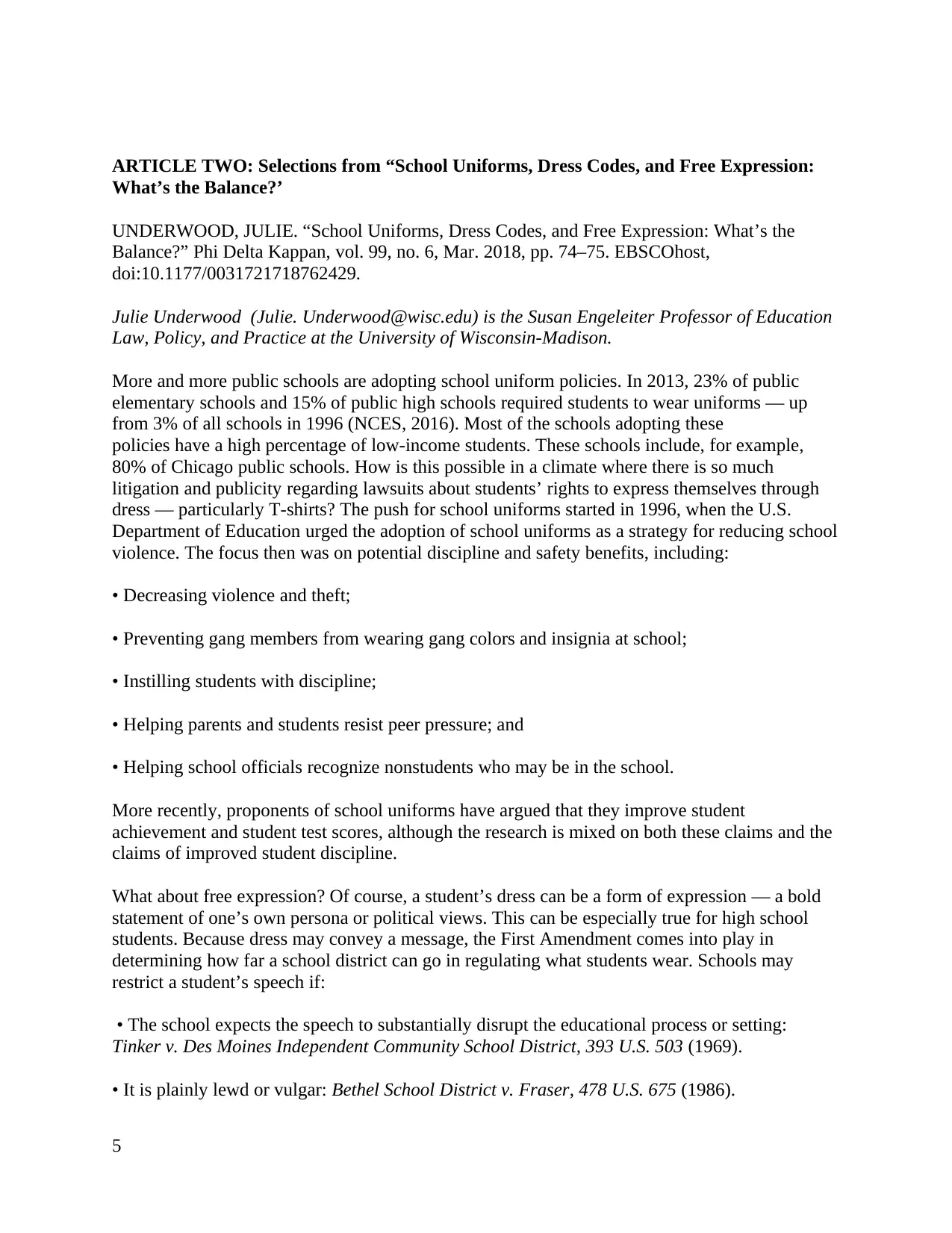
ARTICLE TWO: Selections from “School Uniforms, Dress Codes, and Free Expression:
What’s the Balance?’
UNDERWOOD, JULIE. “School Uniforms, Dress Codes, and Free Expression: What’s the
Balance?” Phi Delta Kappan, vol. 99, no. 6, Mar. 2018, pp. 74–75. EBSCOhost,
doi:10.1177/0031721718762429.
Julie Underwood (Julie. Underwood@wisc.edu) is the Susan Engeleiter Professor of Education
Law, Policy, and Practice at the University of Wisconsin-Madison.
More and more public schools are adopting school uniform policies. In 2013, 23% of public
elementary schools and 15% of public high schools required students to wear uniforms — up
from 3% of all schools in 1996 (NCES, 2016). Most of the schools adopting these
policies have a high percentage of low-income students. These schools include, for example,
80% of Chicago public schools. How is this possible in a climate where there is so much
litigation and publicity regarding lawsuits about students’ rights to express themselves through
dress — particularly T-shirts? The push for school uniforms started in 1996, when the U.S.
Department of Education urged the adoption of school uniforms as a strategy for reducing school
violence. The focus then was on potential discipline and safety benefits, including:
• Decreasing violence and theft;
• Preventing gang members from wearing gang colors and insignia at school;
• Instilling students with discipline;
• Helping parents and students resist peer pressure; and
• Helping school officials recognize nonstudents who may be in the school.
More recently, proponents of school uniforms have argued that they improve student
achievement and student test scores, although the research is mixed on both these claims and the
claims of improved student discipline.
What about free expression? Of course, a student’s dress can be a form of expression — a bold
statement of one’s own persona or political views. This can be especially true for high school
students. Because dress may convey a message, the First Amendment comes into play in
determining how far a school district can go in regulating what students wear. Schools may
restrict a student’s speech if:
• The school expects the speech to substantially disrupt the educational process or setting:
Tinker v. Des Moines Independent Community School District, 393 U.S. 503 (1969).
• It is plainly lewd or vulgar: Bethel School District v. Fraser, 478 U.S. 675 (1986).
5
What’s the Balance?’
UNDERWOOD, JULIE. “School Uniforms, Dress Codes, and Free Expression: What’s the
Balance?” Phi Delta Kappan, vol. 99, no. 6, Mar. 2018, pp. 74–75. EBSCOhost,
doi:10.1177/0031721718762429.
Julie Underwood (Julie. Underwood@wisc.edu) is the Susan Engeleiter Professor of Education
Law, Policy, and Practice at the University of Wisconsin-Madison.
More and more public schools are adopting school uniform policies. In 2013, 23% of public
elementary schools and 15% of public high schools required students to wear uniforms — up
from 3% of all schools in 1996 (NCES, 2016). Most of the schools adopting these
policies have a high percentage of low-income students. These schools include, for example,
80% of Chicago public schools. How is this possible in a climate where there is so much
litigation and publicity regarding lawsuits about students’ rights to express themselves through
dress — particularly T-shirts? The push for school uniforms started in 1996, when the U.S.
Department of Education urged the adoption of school uniforms as a strategy for reducing school
violence. The focus then was on potential discipline and safety benefits, including:
• Decreasing violence and theft;
• Preventing gang members from wearing gang colors and insignia at school;
• Instilling students with discipline;
• Helping parents and students resist peer pressure; and
• Helping school officials recognize nonstudents who may be in the school.
More recently, proponents of school uniforms have argued that they improve student
achievement and student test scores, although the research is mixed on both these claims and the
claims of improved student discipline.
What about free expression? Of course, a student’s dress can be a form of expression — a bold
statement of one’s own persona or political views. This can be especially true for high school
students. Because dress may convey a message, the First Amendment comes into play in
determining how far a school district can go in regulating what students wear. Schools may
restrict a student’s speech if:
• The school expects the speech to substantially disrupt the educational process or setting:
Tinker v. Des Moines Independent Community School District, 393 U.S. 503 (1969).
• It is plainly lewd or vulgar: Bethel School District v. Fraser, 478 U.S. 675 (1986).
5
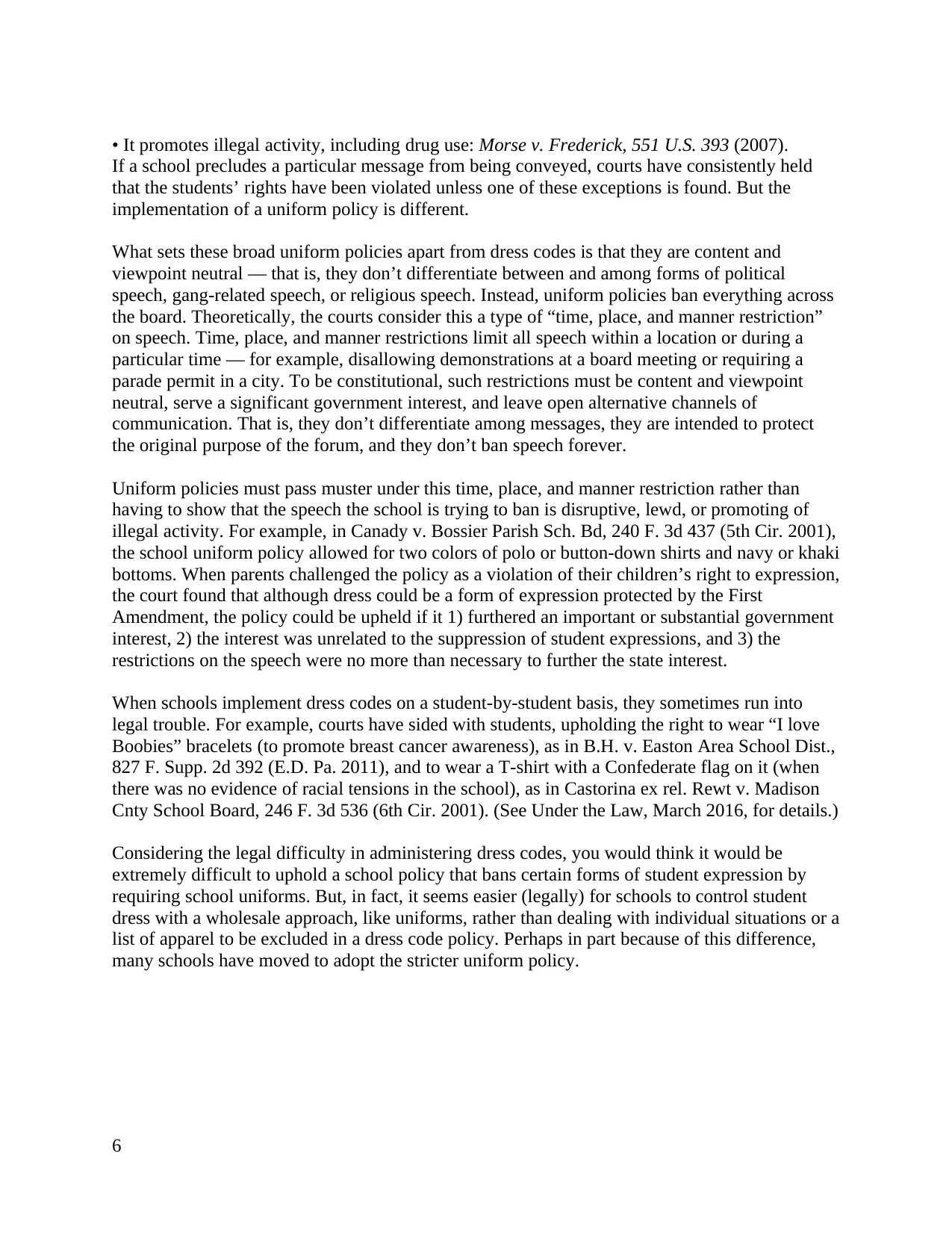
• It promotes illegal activity, including drug use: Morse v. Frederick, 551 U.S. 393 (2007).
If a school precludes a particular message from being conveyed, courts have consistently held
that the students’ rights have been violated unless one of these exceptions is found. But the
implementation of a uniform policy is different.
What sets these broad uniform policies apart from dress codes is that they are content and
viewpoint neutral — that is, they don’t differentiate between and among forms of political
speech, gang-related speech, or religious speech. Instead, uniform policies ban everything across
the board. Theoretically, the courts consider this a type of “time, place, and manner restriction”
on speech. Time, place, and manner restrictions limit all speech within a location or during a
particular time — for example, disallowing demonstrations at a board meeting or requiring a
parade permit in a city. To be constitutional, such restrictions must be content and viewpoint
neutral, serve a significant government interest, and leave open alternative channels of
communication. That is, they don’t differentiate among messages, they are intended to protect
the original purpose of the forum, and they don’t ban speech forever.
Uniform policies must pass muster under this time, place, and manner restriction rather than
having to show that the speech the school is trying to ban is disruptive, lewd, or promoting of
illegal activity. For example, in Canady v. Bossier Parish Sch. Bd, 240 F. 3d 437 (5th Cir. 2001),
the school uniform policy allowed for two colors of polo or button-down shirts and navy or khaki
bottoms. When parents challenged the policy as a violation of their children’s right to expression,
the court found that although dress could be a form of expression protected by the First
Amendment, the policy could be upheld if it 1) furthered an important or substantial government
interest, 2) the interest was unrelated to the suppression of student expressions, and 3) the
restrictions on the speech were no more than necessary to further the state interest.
When schools implement dress codes on a student-by-student basis, they sometimes run into
legal trouble. For example, courts have sided with students, upholding the right to wear “I love
Boobies” bracelets (to promote breast cancer awareness), as in B.H. v. Easton Area School Dist.,
827 F. Supp. 2d 392 (E.D. Pa. 2011), and to wear a T-shirt with a Confederate flag on it (when
there was no evidence of racial tensions in the school), as in Castorina ex rel. Rewt v. Madison
Cnty School Board, 246 F. 3d 536 (6th Cir. 2001). (See Under the Law, March 2016, for details.)
Considering the legal difficulty in administering dress codes, you would think it would be
extremely difficult to uphold a school policy that bans certain forms of student expression by
requiring school uniforms. But, in fact, it seems easier (legally) for schools to control student
dress with a wholesale approach, like uniforms, rather than dealing with individual situations or a
list of apparel to be excluded in a dress code policy. Perhaps in part because of this difference,
many schools have moved to adopt the stricter uniform policy.
6
If a school precludes a particular message from being conveyed, courts have consistently held
that the students’ rights have been violated unless one of these exceptions is found. But the
implementation of a uniform policy is different.
What sets these broad uniform policies apart from dress codes is that they are content and
viewpoint neutral — that is, they don’t differentiate between and among forms of political
speech, gang-related speech, or religious speech. Instead, uniform policies ban everything across
the board. Theoretically, the courts consider this a type of “time, place, and manner restriction”
on speech. Time, place, and manner restrictions limit all speech within a location or during a
particular time — for example, disallowing demonstrations at a board meeting or requiring a
parade permit in a city. To be constitutional, such restrictions must be content and viewpoint
neutral, serve a significant government interest, and leave open alternative channels of
communication. That is, they don’t differentiate among messages, they are intended to protect
the original purpose of the forum, and they don’t ban speech forever.
Uniform policies must pass muster under this time, place, and manner restriction rather than
having to show that the speech the school is trying to ban is disruptive, lewd, or promoting of
illegal activity. For example, in Canady v. Bossier Parish Sch. Bd, 240 F. 3d 437 (5th Cir. 2001),
the school uniform policy allowed for two colors of polo or button-down shirts and navy or khaki
bottoms. When parents challenged the policy as a violation of their children’s right to expression,
the court found that although dress could be a form of expression protected by the First
Amendment, the policy could be upheld if it 1) furthered an important or substantial government
interest, 2) the interest was unrelated to the suppression of student expressions, and 3) the
restrictions on the speech were no more than necessary to further the state interest.
When schools implement dress codes on a student-by-student basis, they sometimes run into
legal trouble. For example, courts have sided with students, upholding the right to wear “I love
Boobies” bracelets (to promote breast cancer awareness), as in B.H. v. Easton Area School Dist.,
827 F. Supp. 2d 392 (E.D. Pa. 2011), and to wear a T-shirt with a Confederate flag on it (when
there was no evidence of racial tensions in the school), as in Castorina ex rel. Rewt v. Madison
Cnty School Board, 246 F. 3d 536 (6th Cir. 2001). (See Under the Law, March 2016, for details.)
Considering the legal difficulty in administering dress codes, you would think it would be
extremely difficult to uphold a school policy that bans certain forms of student expression by
requiring school uniforms. But, in fact, it seems easier (legally) for schools to control student
dress with a wholesale approach, like uniforms, rather than dealing with individual situations or a
list of apparel to be excluded in a dress code policy. Perhaps in part because of this difference,
many schools have moved to adopt the stricter uniform policy.
6
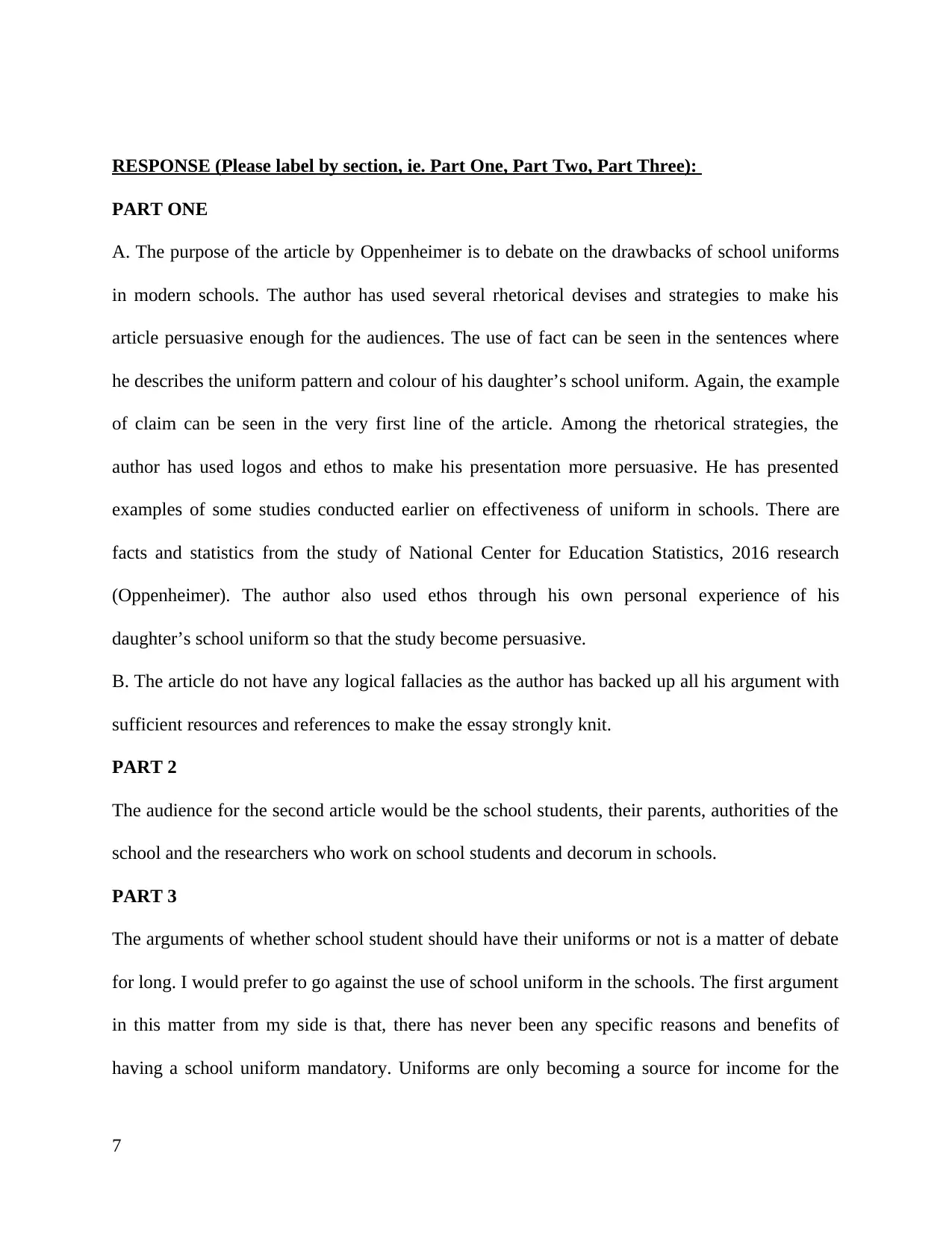
RESPONSE (Please label by section, ie. Part One, Part Two, Part Three):
PART ONE
A. The purpose of the article by Oppenheimer is to debate on the drawbacks of school uniforms
in modern schools. The author has used several rhetorical devises and strategies to make his
article persuasive enough for the audiences. The use of fact can be seen in the sentences where
he describes the uniform pattern and colour of his daughter’s school uniform. Again, the example
of claim can be seen in the very first line of the article. Among the rhetorical strategies, the
author has used logos and ethos to make his presentation more persuasive. He has presented
examples of some studies conducted earlier on effectiveness of uniform in schools. There are
facts and statistics from the study of National Center for Education Statistics, 2016 research
(Oppenheimer). The author also used ethos through his own personal experience of his
daughter’s school uniform so that the study become persuasive.
B. The article do not have any logical fallacies as the author has backed up all his argument with
sufficient resources and references to make the essay strongly knit.
PART 2
The audience for the second article would be the school students, their parents, authorities of the
school and the researchers who work on school students and decorum in schools.
PART 3
The arguments of whether school student should have their uniforms or not is a matter of debate
for long. I would prefer to go against the use of school uniform in the schools. The first argument
in this matter from my side is that, there has never been any specific reasons and benefits of
having a school uniform mandatory. Uniforms are only becoming a source for income for the
7
PART ONE
A. The purpose of the article by Oppenheimer is to debate on the drawbacks of school uniforms
in modern schools. The author has used several rhetorical devises and strategies to make his
article persuasive enough for the audiences. The use of fact can be seen in the sentences where
he describes the uniform pattern and colour of his daughter’s school uniform. Again, the example
of claim can be seen in the very first line of the article. Among the rhetorical strategies, the
author has used logos and ethos to make his presentation more persuasive. He has presented
examples of some studies conducted earlier on effectiveness of uniform in schools. There are
facts and statistics from the study of National Center for Education Statistics, 2016 research
(Oppenheimer). The author also used ethos through his own personal experience of his
daughter’s school uniform so that the study become persuasive.
B. The article do not have any logical fallacies as the author has backed up all his argument with
sufficient resources and references to make the essay strongly knit.
PART 2
The audience for the second article would be the school students, their parents, authorities of the
school and the researchers who work on school students and decorum in schools.
PART 3
The arguments of whether school student should have their uniforms or not is a matter of debate
for long. I would prefer to go against the use of school uniform in the schools. The first argument
in this matter from my side is that, there has never been any specific reasons and benefits of
having a school uniform mandatory. Uniforms are only becoming a source for income for the
7
Paraphrase This Document
Need a fresh take? Get an instant paraphrase of this document with our AI Paraphraser
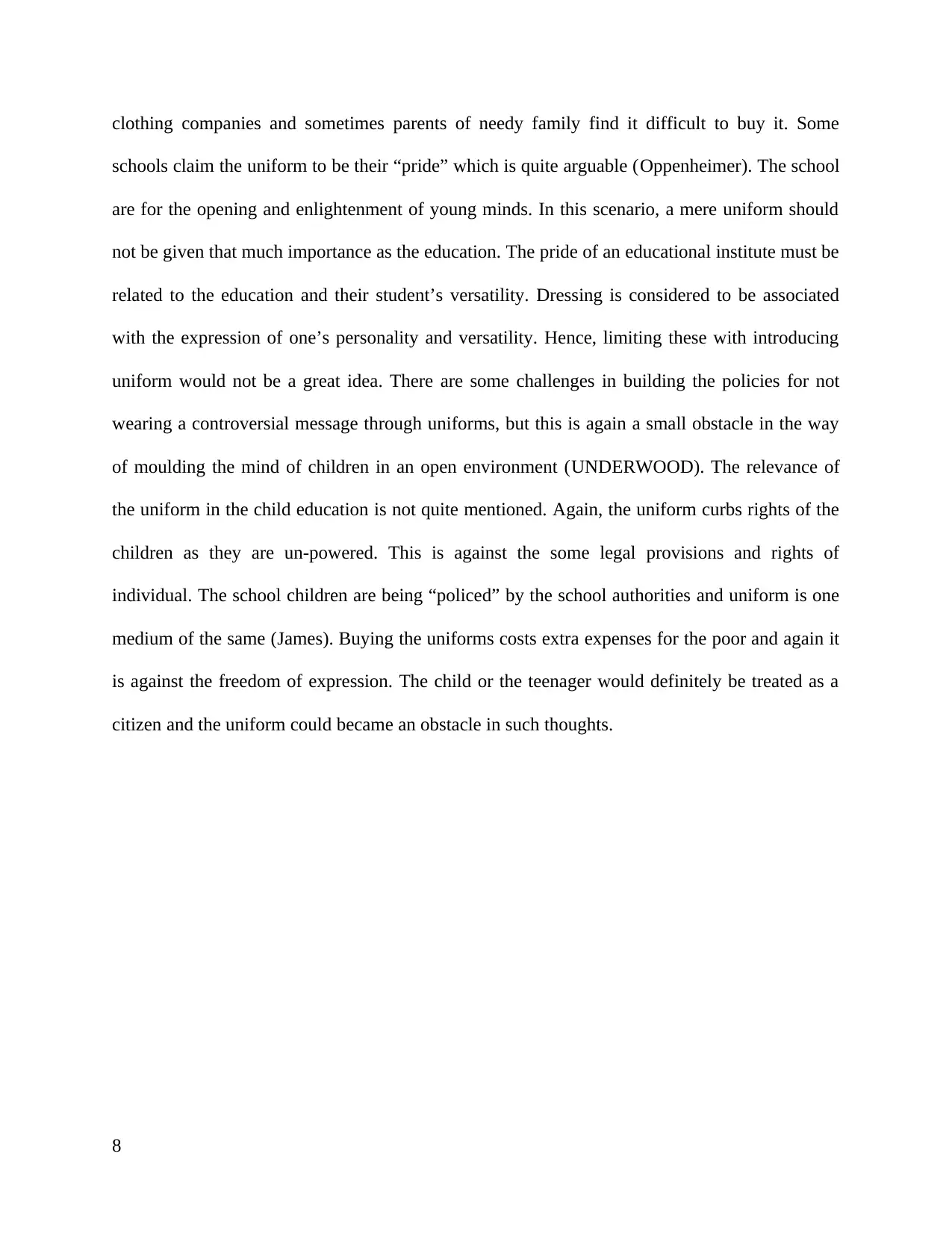
clothing companies and sometimes parents of needy family find it difficult to buy it. Some
schools claim the uniform to be their “pride” which is quite arguable (Oppenheimer). The school
are for the opening and enlightenment of young minds. In this scenario, a mere uniform should
not be given that much importance as the education. The pride of an educational institute must be
related to the education and their student’s versatility. Dressing is considered to be associated
with the expression of one’s personality and versatility. Hence, limiting these with introducing
uniform would not be a great idea. There are some challenges in building the policies for not
wearing a controversial message through uniforms, but this is again a small obstacle in the way
of moulding the mind of children in an open environment (UNDERWOOD). The relevance of
the uniform in the child education is not quite mentioned. Again, the uniform curbs rights of the
children as they are un-powered. This is against the some legal provisions and rights of
individual. The school children are being “policed” by the school authorities and uniform is one
medium of the same (James). Buying the uniforms costs extra expenses for the poor and again it
is against the freedom of expression. The child or the teenager would definitely be treated as a
citizen and the uniform could became an obstacle in such thoughts.
8
schools claim the uniform to be their “pride” which is quite arguable (Oppenheimer). The school
are for the opening and enlightenment of young minds. In this scenario, a mere uniform should
not be given that much importance as the education. The pride of an educational institute must be
related to the education and their student’s versatility. Dressing is considered to be associated
with the expression of one’s personality and versatility. Hence, limiting these with introducing
uniform would not be a great idea. There are some challenges in building the policies for not
wearing a controversial message through uniforms, but this is again a small obstacle in the way
of moulding the mind of children in an open environment (UNDERWOOD). The relevance of
the uniform in the child education is not quite mentioned. Again, the uniform curbs rights of the
children as they are un-powered. This is against the some legal provisions and rights of
individual. The school children are being “policed” by the school authorities and uniform is one
medium of the same (James). Buying the uniforms costs extra expenses for the poor and again it
is against the freedom of expression. The child or the teenager would definitely be treated as a
citizen and the uniform could became an obstacle in such thoughts.
8
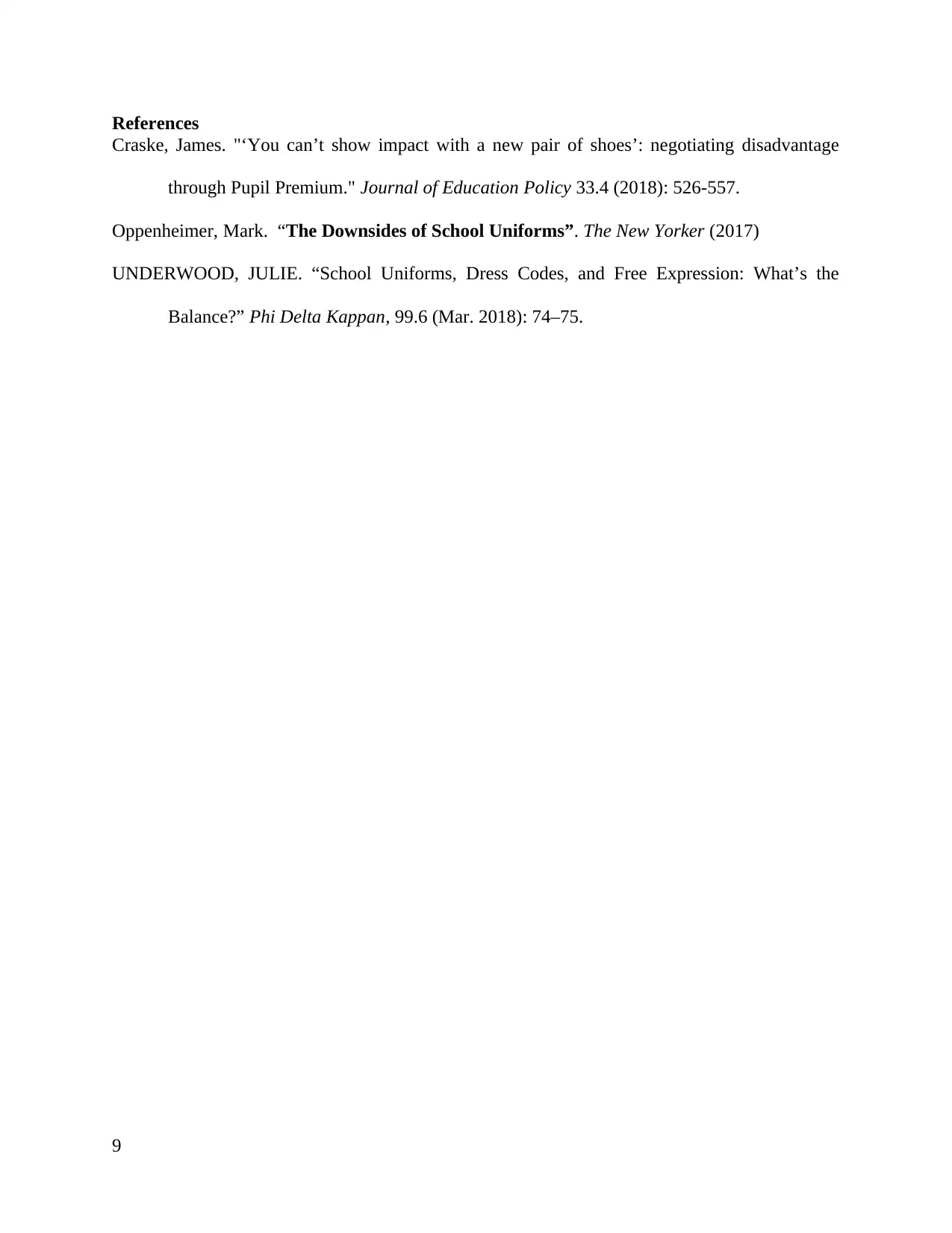
References
Craske, James. "‘You can’t show impact with a new pair of shoes’: negotiating disadvantage
through Pupil Premium." Journal of Education Policy 33.4 (2018): 526-557.
Oppenheimer, Mark. “The Downsides of School Uniforms”. The New Yorker (2017)
UNDERWOOD, JULIE. “School Uniforms, Dress Codes, and Free Expression: What’s the
Balance?” Phi Delta Kappan, 99.6 (Mar. 2018): 74–75.
9
Craske, James. "‘You can’t show impact with a new pair of shoes’: negotiating disadvantage
through Pupil Premium." Journal of Education Policy 33.4 (2018): 526-557.
Oppenheimer, Mark. “The Downsides of School Uniforms”. The New Yorker (2017)
UNDERWOOD, JULIE. “School Uniforms, Dress Codes, and Free Expression: What’s the
Balance?” Phi Delta Kappan, 99.6 (Mar. 2018): 74–75.
9
1 out of 9
Related Documents
Your All-in-One AI-Powered Toolkit for Academic Success.
+13062052269
info@desklib.com
Available 24*7 on WhatsApp / Email
![[object Object]](/_next/static/media/star-bottom.7253800d.svg)
Unlock your academic potential
© 2024 | Zucol Services PVT LTD | All rights reserved.





